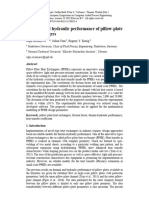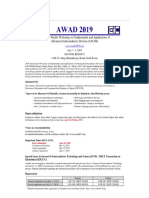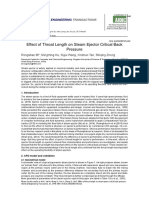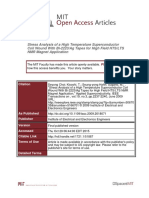Atp Project-1 Final
Uploaded by
Anush KoreCopyright:
Available Formats
Atp Project-1 Final
Uploaded by
Anush KoreCopyright
Available Formats
Share this document
Did you find this document useful?
Is this content inappropriate?
Copyright:
Available Formats
Atp Project-1 Final
Uploaded by
Anush KoreCopyright:
Available Formats
Simulation of Shell & Tube Heat Exchanger
Anujkumar Prafulbhai Thakkar – 300384018 & Anush Kore - 300375288
Term Project 1 for CHG 8116: Advanced Transport Phenomena
November 06, 2023
Abstract
The aim of this numerical study is to simulate 1-1 pass shell and tube heat exchanger using ANSYS Fluent
software. The primary focused were on analysing the impact of baffles cut on pressure drop and evaluation of
temperature profile in shell and tube heat exchanger. To implement said intentions, particularly, continuity
equation, energy equation and k-epsilon model for turbulent case were applied to this steady state analysis of
hex dominant meshed geometry. Particularly, water has been used as shell and tube side fluid as well as steel
has been used for solid parts of shell and tube heat exchamger. Baffles space was varied as 35% cut and 45%
cut. It has been observed from the simulation results that pressure drop for 35% baffle cut was 1454 Pa and
for 45% baffle cut was 1430 Pa.
Introduction
Heat exchangers are integral part of many industries and widely used to transfer energy from one fluid to
another. There are several types of heat exchangers exists such as plate type heat exchanger, double pipe heat
exchanger, and shell and tube heat exchanger. Amongst them shell and tube heat exchanger are extensively
used because of its design simplicity and wide range of characteristics. There is innumerable research has been
done on the design of shell and tube heat exchanger to provide excellent efficiency with lowest cost. In one
study, simulation of shell and tube heat exchanger done using baffles to increase the flow rate of highly viscous
liquid. [1]. Another study was conducted using MATLAB to analyse the effect of baffle spacing on dimensions
of heat exchangers [2]. There is also a study on calculation of overall heat transfer coefficient using COSMOL
software. [3]. One more study was conducted on shell-and-tube heat exchanger with different (staggered grid
and inline) arrangement considering different mass flow rate of shell side (tube flow kept constant). They found
that staggered grid arrangement is less effective than inline arrangement [4].
In this study, effect of baffle cut on pressure drop and temperature profile has been analysed. The model of
shell and tube heat exchanger with baffles was implemented in Design Modeler. The hex dominant meshing
approach has been implemented and set up is created in ANSYS fluent student version. Inlet temperature of
hot and cold fluids was kept at 40 ◦C and 20 ◦C respectively, whereas inlet velocity of hot and cold fluids kept
at 0.7 m/s and 1.2 m/s. The material for heat exchanger body was considered as steel and water was used as
fluid. To evaluate decided objectives, simulation has been conducted and results have been compared to
provide conclusions.
Methodology
Shell and tube heat exchanger with 5 numbers of tubes and 6 numbers of baffles is created in ANSYS Fluent
(student version). After creating a geometry meshing was implemented to the designed model of shell and
Term Project 1 for CHG 8116 Page 1 of 8
Simulation of Shell and Tube HE Anuj Thakkar(300384018), Anush Kore(300375288)
tube heat exchanger followed by pre-setup. A hex dominant meshing method was applied to create mesh. Due
to the limitations of student version of ANSYS Fluent, less precise methods were utilised to achieve physical
solution as meshing was not very fine. Results and data evaluation has been done based on generated solution
from applied boundary conditions and methods.
Geometry and Mesh
Geometry
A baffled shell and tube heat exchanger created using design modeler. It is very important to specify different
dimensions very precisely while creating thermal model. In this study tube diameter, shell diameter, shell and
tube length, tube arrangement, baffle spacing, tube pitch, and nozzle sizing were finalised to create geometry.
Figure 1 represents the geometry of baffled shell and tube heat exchanger. In this study, cold fluid is intended
to pass through shell and hot fluid through the tubes.
Figure 1.: Geometry with shell and tube heat exchanger with 5 tubes and 6 baffles
Dimensions
Below table shows the dimensions and other details of Shell and tube heat exchangers:
Table 1. Details of Shell and Tube Heat Exchanger
Details
Shell Length 67.5 cm
Shell Diameter 10 cm
Term Project 1 for CHG 8116 Page 2 of 8
Simulation of Shell and Tube HE Anuj Thakkar(300384018), Anush Kore(300375288)
Tube Length 67.5 cm
Tube Diameter 1.5 cm
Length of Heat Exchanger 77.5 cm
Numbers of Tubes 5 Nos
Tube Pitch (Pt) 2.5 cm
Numbers of Baffles 6 Nos
Baffles pitch (Bs) 10 cm
Meshing
Meshing is the process of dividing a geometry into small, finite elements to discretize the domain. It involves
breaking whole geometry into small shapes such as triangles, quadrilaterals, tetrahedra, or hexahedra in 2D or
3D space. Appropriate and fine meshing is very important as it plays vital role in numerical solution, accuracy,
boundary conditions and solver convergence.
In this study, we have applied “Hex dominant” meshing method. Figure 2 illustrates details regarding meshing
approach and name creation. The total number of elements were 278611.
Figure 2.: Meshing approach and name selection
Term Project 1 for CHG 8116 Page 3 of 8
Simulation of Shell and Tube HE Anuj Thakkar(300384018), Anush Kore(300375288)
Governing Equations
There were set of equations that governed the simulations. Following governing equations were considered
for this study:
Conservation of Mass
𝝏𝝆 (1)
+ 𝛁. (𝝆𝝊) = 𝟎
𝝏𝒕
Momentum Equations
X-Component:
𝑫𝒖 𝝏𝒑 𝝏𝝉𝒙𝒙 𝝏𝝉𝒚𝒙 𝝏𝝉𝒛𝒙 (2)
𝝆 = − + + + + 𝝆𝒇𝒙
𝑫𝒕 𝝏𝒙 𝝏𝒙 𝝏𝒚 𝝏𝒛
Y-Component:
𝑫𝒖 𝝏𝒑 𝝏𝝉𝒙𝒚 𝝏𝝉𝒚𝒚 𝝏𝝉𝒙𝒛
𝝆 = − + + + + 𝝆𝒇𝒚 (3)
𝑫𝒕 𝝏𝒚 𝝏𝒙 𝝏𝒚 𝝏𝒛
Z-Component:
𝑫𝒖 𝝏𝒑 𝝏𝝉𝒙𝒛 𝝏𝝉𝒚𝒛 𝝏𝝉𝒛𝒛
𝝆 = − + + + + 𝝆𝒇𝒛 (4)
𝑫𝒕 𝝏𝒛 𝝏𝒙 𝝏𝒚 𝝏𝒛
Energy Equation
̇ 𝑻 = 𝐦𝐂𝐩𝚫̇T
−𝐤𝚫 (5)
Term Project 1 for CHG 8116 Page 4 of 8
Simulation of Shell and Tube HE Anuj Thakkar(300384018), Anush Kore(300375288)
Numerical Settings
Numerical settings are the most important part of any simulations to receive accurate and stable solutions. In
this study, several assumptions were considered, and boundary conditions were applied to physical model
while creating numerical solution.
Assumptions
• Steady state analysis and incompressible flow considered.
• Turbulent flow condition is considered.
Boundary Conditions
Table 2 illustrates the boundary conditions which were applied to this study:
Table 2. Applied Boundary Conditions
Physical Location Boundary Condition
Shell Wall Adiabatic Wall (q=0)
Shell Outlet Pressure Outlet (P=Patm, T=Tatm)
Tube Outlet Pressure Outlet (P=Patm, T=Tatm)
Pipe Wall Conjugate Heat Transfer
Shell Inlet Velocity Inet (Velocity=1.2 m/s & Temperature=40 ◦C)
Tube Inlet Velocity Inet (Velocity=0.7 m/s & Temperature=20 ◦C)
Solution Methods and Controls
Below table is showing applied methods, and controls for the simulation.
Table 3. Numerical Setup
Solution Method Under Relaxation Factors
Pressure-Velocity Scheme SIMPLE
Gradient Green Gauss Node Based
Pressure Standard 0.3
Momentum First Order Upwind 0.7
Turbulent Kinetic Energy First Order Upwind 0.8
Turbulent Dissipation Rate First Order Upwind 0.7
Energy First Order Upwind 0.7
Turbulent Viscosity - 1
Density - 1
Body Face - 1
Residuals
• Continuity: 1e-5,
• Momentum (X, Y, and Z Componentes): 1e-6
• Energy (X, Y, and Z Componentes): 1e-6
Term Project 1 for CHG 8116 Page 5 of 8
Simulation of Shell and Tube HE Anuj Thakkar(300384018), Anush Kore(300375288)
Post-processing and Data Analysis
After successful simulation of 45% cut baffles case and 35% cut baffles case, data has been generated. To
evaluate results several approaches has been considered. Contour of shell and tube side flow, graphical
representation of vectors and streamline data were generated. Flow trend have been seen correctly as per
input data in generated graphics. Apart from this, streamlines of temperature, pressure and velocity were in
order. Following figures reflects the generated results.
Figure 3.: Pressure streamlines of 35% baffle cut Figure 4.: Temperature streamlines of 35% baffle cut
Figure 3.: Pressure streamlines of 45% baffle cut Figure 4.: Temperature streamlines of 45% baffle cut
Term Project 1 for CHG 8116 Page 6 of 8
Simulation of Shell and Tube HE Anuj Thakkar(300384018), Anush Kore(300375288)
Case Studies
In this study, 2 cases were considered to compare the results. Firstly, baffles with 35% cut were added to
geometry and simulation were performed. Secondly, baffles with 45% cut were added to geometry and
simulation were performed with similar meshing approach, boundary conditions and numerical settings.
In this study, water is considered as both shell and tube side fluid and steel are considered for solid bodies.
Fluid (water) and solid (steel) properties in this study was used from ANSYS databank. Shell side Reynold
number in this study was 36906.
Verification and Validation
Generated trend and data were analysed and compared for verification and validation purpose. Shell side
pressure drop generated by numerical solution is compared with analytical solution generated by theoretical
calculations. Below are the results generated from numerical solution.
Table 4. Numerical Results
35% Baffle cut 45% Baffle cut
Shell Side Pressure Drop 1454 Pa 1430 Pa
Shell Side Outlet Temperature 14 ◦C 14 ◦C
Tube Side Outlet Temperature 34 ◦C 31 ◦C
The pressure drop obtained from analytical solution was around 963 Pa whereas, the pressure drop obtained
from numerical solution was around 1454 Pa and 1430 Pa for 35% baffle cut and 45% baffle cut respectively.
The analytical calculation for shell side pressure drop is as following Shell side Pressure Drop Calculation.
Results and Discussion
It has been observed from the study that different design of baffles significantly impacts the pressure drop in
shell and tube heat exchanger. Generated data in simulation indicates that increase in baffle cut is significantly
decrease the pressure drop. However, in this study temperature gradient for shell side fluid was found same.
On the other hand, 3 degrees Celsius temperature gradient difference was noted between the tube side fluid
with baffle cuts of 35% and 45%. Moreover, more stable residuals have been observed in 35% baffle cut rather
than 45%.
Conclusion
In this study, shell and tube heat exchanger was simulated using ANSYS Fluent for two different percent of
baffle cut cases. Due to the limitations of student version of ANSYS Fluent there were not very fine meshing
achieved. However, trends and results produced from simulation are reliable. Observed trends of temperature,
pressure and velocity were in order of streamline charts. All the discussed results indicates that if high
resolution meshing was done then promising data could be generated with similar study.
Nomenclature
Bs Baffle Spacing [cm]
Term Project 1 for CHG 8116 Page 7 of 8
Simulation of Shell and Tube HE Anuj Thakkar(300384018), Anush Kore(300375288)
Pt Tube Pitch [cm]
v Velocity in Eq. (1) [m s-1]
P Pressure [Pa]
𝜌 Density [kg m3]
u Velocity in Eq. (2), (3) & (4) [m s-1]
k Thermal Conductivity [W m-1 C-1]
Cp Specific Heat Capacity [J kg-1 C-1]
t Time [s]
T Temperature [K]
References:
• Heat Transfer – A practical approach (second edition) by Yunus A Cengel
• Shubham Sharma, Shalab Sharma, Mandeep Singh, Parampreet Singh, Rasmeet Singh, Sthitapragyan
Maharana, Nima Khalipoor, Alibek Issakhov, “ Computational Fluid Dynamics Analysis of Flow Patterns,
Pressure Drop, and Heat Transfer Coefficient in Staggered and Inline Shell-Tube Heat Exchangers,
2021, Hindawi - Mathematical Problems in Engineering Volume 2021, Article ID 6645128, doi:
https://doi.org/10.1155/2021/6645128
• Trung Kim Nguyen et al 2021 IOP Conf. Ser.: Earth Environ. Sci. 947 012008, “Simulation of shell and
tube heat exchanger using COMSOL software”, doi: https://doi.org/10.1088/1755-
1315/947/1/012008
• S. K. Katarki and A. S. Malipatil, “CFD Analysis of Shell and Tube Heat Exchanger for Heat Transfer
Capabilities Abstract:”, vol. 3, no. 6, pp. 102–106, 2017
• M. Irshad, M. Kaushar, and G. Rajmohan, “Design and CFD Analysis of Shell and Tube Heat Exchanger,”
vol. 7, no. 4, 2017
Term Project 1 for CHG 8116 Page 8 of 8
You might also like
- Ford AOD E Transmission Service and Repair Manual100% (1)Ford AOD E Transmission Service and Repair Manual112 pages
- Heat Transfer Analysis of Integral-Fin TubesNo ratings yetHeat Transfer Analysis of Integral-Fin Tubes12 pages
- Simulation of Shell & Tube Heat ExchangerNo ratings yetSimulation of Shell & Tube Heat Exchanger8 pages
- Heat Transfer of Double Pipe Heat Exchanger Performance by Using Nanofluids and Serrated FinsNo ratings yetHeat Transfer of Double Pipe Heat Exchanger Performance by Using Nanofluids and Serrated Fins12 pages
- Analysis of Exhaust Manifold of 4-Cylinder Si Engine Using CFDNo ratings yetAnalysis of Exhaust Manifold of 4-Cylinder Si Engine Using CFD14 pages
- A New Statistical Framework For The Determination of Safe Creep Life Using The Theta Projection TechniqueNo ratings yetA New Statistical Framework For The Determination of Safe Creep Life Using The Theta Projection Technique12 pages
- Prediction of Thermal Fatigue Life of A Turbine Nozzle Guide VaneNo ratings yetPrediction of Thermal Fatigue Life of A Turbine Nozzle Guide Vane9 pages
- Shell Side CFD Analysis of A Model Shell-and-Tube Heat ExchangerNo ratings yetShell Side CFD Analysis of A Model Shell-and-Tube Heat Exchanger6 pages
- Optimal Design of Shell and Tube Heat Exchanger Using Genetic AlgorithmsNo ratings yetOptimal Design of Shell and Tube Heat Exchanger Using Genetic Algorithms6 pages
- Performance Analysis of Shell and Tube Heat ExchangersNo ratings yetPerformance Analysis of Shell and Tube Heat Exchangers5 pages
- Design Optimization of Shell-And-Tube Heat Exchangers: Andre L.H. Costa, Eduardo M. QueirozNo ratings yetDesign Optimization of Shell-And-Tube Heat Exchangers: Andre L.H. Costa, Eduardo M. Queiroz8 pages
- Study On The Influence of Tube Curvature On Heat TNo ratings yetStudy On The Influence of Tube Curvature On Heat T12 pages
- InTech-Optimal Shell and Tube Heat Ex Changers DesignNo ratings yetInTech-Optimal Shell and Tube Heat Ex Changers Design30 pages
- Numerical and Experimental Modelling of The Steam Assisted Gravity Drainage (SAGD) ProcessNo ratings yetNumerical and Experimental Modelling of The Steam Assisted Gravity Drainage (SAGD) Process7 pages
- Analysis and Design of Cryogenic Ball ValveNo ratings yetAnalysis and Design of Cryogenic Ball Valve6 pages
- Study On Time Dependent Dielectric BreakdownNo ratings yetStudy On Time Dependent Dielectric Breakdown4 pages
- Cost Optimization Using Genetic Algorithm: Steam Surface Condenser Design Based OnNo ratings yetCost Optimization Using Genetic Algorithm: Steam Surface Condenser Design Based On6 pages
- The Failure Behavior of An Epoxy Resin Subject To Multiaxial LoadingNo ratings yetThe Failure Behavior of An Epoxy Resin Subject To Multiaxial Loading9 pages
- Effect of Throat Length On Steam Ejector Critical Back PressureNo ratings yetEffect of Throat Length On Steam Ejector Critical Back Pressure6 pages
- Simulation-Based Design Method For Room Air Conditioner With Smaller Diameter Copper TubesNo ratings yetSimulation-Based Design Method For Room Air Conditioner With Smaller Diameter Copper Tubes8 pages
- James Ron Martinez Heating Surface of A BoilerNo ratings yetJames Ron Martinez Heating Surface of A Boiler18 pages
- Metals: Strain Localization During Equal-Channel Angular Pressing Analyzed by Finite Element SimulationsNo ratings yetMetals: Strain Localization During Equal-Channel Angular Pressing Analyzed by Finite Element Simulations18 pages
- Lec 5 Shell and Tube Heat Exchanger Part 2 FinalNo ratings yetLec 5 Shell and Tube Heat Exchanger Part 2 Final16 pages
- Models - Heat.shell and Tube Heat ExchangerNo ratings yetModels - Heat.shell and Tube Heat Exchanger26 pages
- Comparison of Two FEA Models For Calculating Stresses in Shell-And-tube Heat ExchangerNo ratings yetComparison of Two FEA Models For Calculating Stresses in Shell-And-tube Heat Exchanger5 pages
- Numerical Simulation of The Temperaturbe Filed in fixed-TIG Welding PoolNo ratings yetNumerical Simulation of The Temperaturbe Filed in fixed-TIG Welding Pool5 pages
- Mahesh Gupta, Michigan Technological University Plastic Flow, LLC Houghton, MI 49931 Houghton, MI 49931No ratings yetMahesh Gupta, Michigan Technological University Plastic Flow, LLC Houghton, MI 49931 Houghton, MI 499315 pages
- Stress Analysis of A High Temperature Superconductor Coil Wound With Bi-2223/Ag Tapes For High Field HTS/LTS NMR Magnet ApplicationNo ratings yetStress Analysis of A High Temperature Superconductor Coil Wound With Bi-2223/Ag Tapes For High Field HTS/LTS NMR Magnet Application5 pages
- CFD Analysis and Experimental Investigations Towards Optimizing The Parameters of Ranque-Hilsch Vortex TubeNo ratings yetCFD Analysis and Experimental Investigations Towards Optimizing The Parameters of Ranque-Hilsch Vortex Tube13 pages
- Numerical Study of Shell-And-Tube Heat Exchanger Performance With Various Baffle SpacingNo ratings yetNumerical Study of Shell-And-Tube Heat Exchanger Performance With Various Baffle Spacing7 pages
- 1346 Advances in Large-Eddy Simulation of A Wind Turbine Wake LES Jimenez, A - Crespo, A - Migoya, E - Garcia, J 2007No ratings yet1346 Advances in Large-Eddy Simulation of A Wind Turbine Wake LES Jimenez, A - Crespo, A - Migoya, E - Garcia, J 200714 pages
- Design of Shell-And-Tube Heat Exchangers by Using CFD Technique - Part One: Thermo-Hydraulic CalculationNo ratings yetDesign of Shell-And-Tube Heat Exchangers by Using CFD Technique - Part One: Thermo-Hydraulic Calculation15 pages
- Design and Simulation of MEMS-based Dual-Axis Uidic Angular Velocity SensorNo ratings yetDesign and Simulation of MEMS-based Dual-Axis Uidic Angular Velocity Sensor6 pages
- Failure Avoidance Brief: Estimating Heater Tube Life: FeatureNo ratings yetFailure Avoidance Brief: Estimating Heater Tube Life: Feature3 pages
- Hydrodynamic Model For The Plasma-Gas Flow in A Cutting Torch NozzleNo ratings yetHydrodynamic Model For The Plasma-Gas Flow in A Cutting Torch Nozzle7 pages
- A Study of Strain and Deformation Measurement Using The Arduino Microcontroller and Strain Gauges DevicesNo ratings yetA Study of Strain and Deformation Measurement Using The Arduino Microcontroller and Strain Gauges Devices7 pages
- Effect of Corrugated Baffles On The Flow and Thermal Fields in A Channel Heat ExchangerNo ratings yetEffect of Corrugated Baffles On The Flow and Thermal Fields in A Channel Heat Exchanger10 pages
- Effect of Steam Temperature Fluctuations On Remanant LifeNo ratings yetEffect of Steam Temperature Fluctuations On Remanant Life10 pages
- Mathematical and Computational Modeling: With Applications in Natural and Social Sciences, Engineering, and the ArtsFrom EverandMathematical and Computational Modeling: With Applications in Natural and Social Sciences, Engineering, and the ArtsRoderick MelnikNo ratings yet
- A First Course in Dimensional Analysis: Simplifying Complex Phenomena Using Physical InsightFrom EverandA First Course in Dimensional Analysis: Simplifying Complex Phenomena Using Physical InsightNo ratings yet
- Public Transport (Bus) Accessibility Plan The Historic Core of Bangalore CityNo ratings yetPublic Transport (Bus) Accessibility Plan The Historic Core of Bangalore City44 pages
- Bonding Compounds For Interior Gypsum PlasteringNo ratings yetBonding Compounds For Interior Gypsum Plastering5 pages
- Grade 8 - Archimedes: Pigcarangan Integrated School Weekly Home Learning PlanNo ratings yetGrade 8 - Archimedes: Pigcarangan Integrated School Weekly Home Learning Plan4 pages
- Ch23 Machining Processes Turning and Hole Making2100% (1)Ch23 Machining Processes Turning and Hole Making272 pages
- The Mystery of Membrane Organization Composition, Regulation and Roles of Lipid RaftsNo ratings yetThe Mystery of Membrane Organization Composition, Regulation and Roles of Lipid Rafts14 pages
- EEE 309 Communication Theory: Semester: January 2017 Semester: January 2017No ratings yetEEE 309 Communication Theory: Semester: January 2017 Semester: January 201712 pages
- Tenarishydril Wedge 563 Connection: ScopeNo ratings yetTenarishydril Wedge 563 Connection: Scope16 pages
- Chemistry For Engineers 1 Energy Topic 04 Nuclear Chemistry 1No ratings yetChemistry For Engineers 1 Energy Topic 04 Nuclear Chemistry 16 pages
- Chapter 5 - Transportation Planning Process100% (2)Chapter 5 - Transportation Planning Process28 pages
- Heat Transfer of Double Pipe Heat Exchanger Performance by Using Nanofluids and Serrated FinsHeat Transfer of Double Pipe Heat Exchanger Performance by Using Nanofluids and Serrated Fins
- Analysis of Exhaust Manifold of 4-Cylinder Si Engine Using CFDAnalysis of Exhaust Manifold of 4-Cylinder Si Engine Using CFD
- A New Statistical Framework For The Determination of Safe Creep Life Using The Theta Projection TechniqueA New Statistical Framework For The Determination of Safe Creep Life Using The Theta Projection Technique
- Prediction of Thermal Fatigue Life of A Turbine Nozzle Guide VanePrediction of Thermal Fatigue Life of A Turbine Nozzle Guide Vane
- Shell Side CFD Analysis of A Model Shell-and-Tube Heat ExchangerShell Side CFD Analysis of A Model Shell-and-Tube Heat Exchanger
- Optimal Design of Shell and Tube Heat Exchanger Using Genetic AlgorithmsOptimal Design of Shell and Tube Heat Exchanger Using Genetic Algorithms
- Performance Analysis of Shell and Tube Heat ExchangersPerformance Analysis of Shell and Tube Heat Exchangers
- Design Optimization of Shell-And-Tube Heat Exchangers: Andre L.H. Costa, Eduardo M. QueirozDesign Optimization of Shell-And-Tube Heat Exchangers: Andre L.H. Costa, Eduardo M. Queiroz
- Study On The Influence of Tube Curvature On Heat TStudy On The Influence of Tube Curvature On Heat T
- InTech-Optimal Shell and Tube Heat Ex Changers DesignInTech-Optimal Shell and Tube Heat Ex Changers Design
- Numerical and Experimental Modelling of The Steam Assisted Gravity Drainage (SAGD) ProcessNumerical and Experimental Modelling of The Steam Assisted Gravity Drainage (SAGD) Process
- Cost Optimization Using Genetic Algorithm: Steam Surface Condenser Design Based OnCost Optimization Using Genetic Algorithm: Steam Surface Condenser Design Based On
- The Failure Behavior of An Epoxy Resin Subject To Multiaxial LoadingThe Failure Behavior of An Epoxy Resin Subject To Multiaxial Loading
- Effect of Throat Length On Steam Ejector Critical Back PressureEffect of Throat Length On Steam Ejector Critical Back Pressure
- Simulation-Based Design Method For Room Air Conditioner With Smaller Diameter Copper TubesSimulation-Based Design Method For Room Air Conditioner With Smaller Diameter Copper Tubes
- Metals: Strain Localization During Equal-Channel Angular Pressing Analyzed by Finite Element SimulationsMetals: Strain Localization During Equal-Channel Angular Pressing Analyzed by Finite Element Simulations
- Comparison of Two FEA Models For Calculating Stresses in Shell-And-tube Heat ExchangerComparison of Two FEA Models For Calculating Stresses in Shell-And-tube Heat Exchanger
- Numerical Simulation of The Temperaturbe Filed in fixed-TIG Welding PoolNumerical Simulation of The Temperaturbe Filed in fixed-TIG Welding Pool
- Mahesh Gupta, Michigan Technological University Plastic Flow, LLC Houghton, MI 49931 Houghton, MI 49931Mahesh Gupta, Michigan Technological University Plastic Flow, LLC Houghton, MI 49931 Houghton, MI 49931
- Stress Analysis of A High Temperature Superconductor Coil Wound With Bi-2223/Ag Tapes For High Field HTS/LTS NMR Magnet ApplicationStress Analysis of A High Temperature Superconductor Coil Wound With Bi-2223/Ag Tapes For High Field HTS/LTS NMR Magnet Application
- CFD Analysis and Experimental Investigations Towards Optimizing The Parameters of Ranque-Hilsch Vortex TubeCFD Analysis and Experimental Investigations Towards Optimizing The Parameters of Ranque-Hilsch Vortex Tube
- Numerical Study of Shell-And-Tube Heat Exchanger Performance With Various Baffle SpacingNumerical Study of Shell-And-Tube Heat Exchanger Performance With Various Baffle Spacing
- 1346 Advances in Large-Eddy Simulation of A Wind Turbine Wake LES Jimenez, A - Crespo, A - Migoya, E - Garcia, J 20071346 Advances in Large-Eddy Simulation of A Wind Turbine Wake LES Jimenez, A - Crespo, A - Migoya, E - Garcia, J 2007
- Design of Shell-And-Tube Heat Exchangers by Using CFD Technique - Part One: Thermo-Hydraulic CalculationDesign of Shell-And-Tube Heat Exchangers by Using CFD Technique - Part One: Thermo-Hydraulic Calculation
- Design and Simulation of MEMS-based Dual-Axis Uidic Angular Velocity SensorDesign and Simulation of MEMS-based Dual-Axis Uidic Angular Velocity Sensor
- Failure Avoidance Brief: Estimating Heater Tube Life: FeatureFailure Avoidance Brief: Estimating Heater Tube Life: Feature
- Hydrodynamic Model For The Plasma-Gas Flow in A Cutting Torch NozzleHydrodynamic Model For The Plasma-Gas Flow in A Cutting Torch Nozzle
- A Study of Strain and Deformation Measurement Using The Arduino Microcontroller and Strain Gauges DevicesA Study of Strain and Deformation Measurement Using The Arduino Microcontroller and Strain Gauges Devices
- Effect of Corrugated Baffles On The Flow and Thermal Fields in A Channel Heat ExchangerEffect of Corrugated Baffles On The Flow and Thermal Fields in A Channel Heat Exchanger
- Effect of Steam Temperature Fluctuations On Remanant LifeEffect of Steam Temperature Fluctuations On Remanant Life
- Mathematical and Computational Modeling: With Applications in Natural and Social Sciences, Engineering, and the ArtsFrom EverandMathematical and Computational Modeling: With Applications in Natural and Social Sciences, Engineering, and the Arts
- A First Course in Dimensional Analysis: Simplifying Complex Phenomena Using Physical InsightFrom EverandA First Course in Dimensional Analysis: Simplifying Complex Phenomena Using Physical Insight
- Public Transport (Bus) Accessibility Plan The Historic Core of Bangalore CityPublic Transport (Bus) Accessibility Plan The Historic Core of Bangalore City
- Grade 8 - Archimedes: Pigcarangan Integrated School Weekly Home Learning PlanGrade 8 - Archimedes: Pigcarangan Integrated School Weekly Home Learning Plan
- The Mystery of Membrane Organization Composition, Regulation and Roles of Lipid RaftsThe Mystery of Membrane Organization Composition, Regulation and Roles of Lipid Rafts
- EEE 309 Communication Theory: Semester: January 2017 Semester: January 2017EEE 309 Communication Theory: Semester: January 2017 Semester: January 2017
- Chemistry For Engineers 1 Energy Topic 04 Nuclear Chemistry 1Chemistry For Engineers 1 Energy Topic 04 Nuclear Chemistry 1

























































































